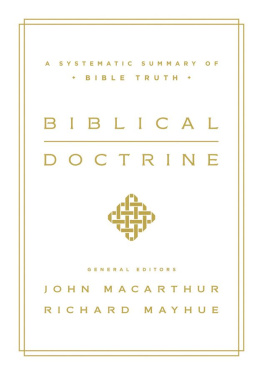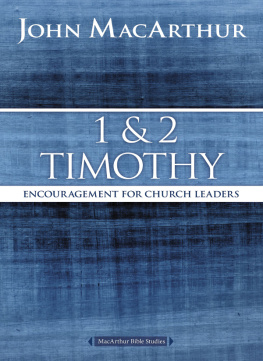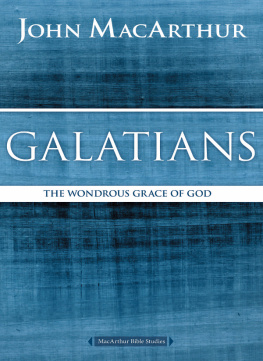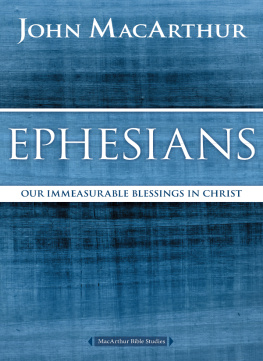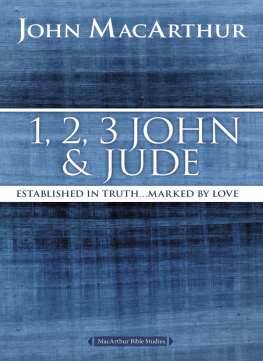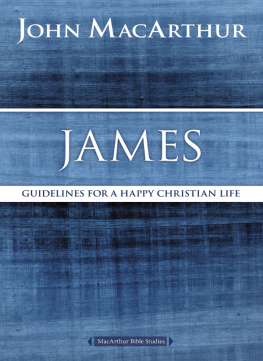
1 & 2 PETER
MACARTHUR BIBLE STUDIES
2007, John F. MacArthur, Jr.
All rights reserved. No portion of this book may be reproduced, stored in a retrieval system, or transmitted in any form or by any meanselectronic, mechanical, photocopy, recording, or any otherexcept for brief quotations in printed reviews, without the prior permission of the publisher.
Published in Nashville, Tennessee, by Nelson Books, an imprint of Thomas Nelson. Nelson Books and Thomas Nelson are registered trademarks of HarperCollins Christian Publishing, Inc.
Nelson Books titles may be purchased in bulk for education, business, fundraising, or sales promotional use. For information, please email SpecialMarkets@ThomasNelson.com.
Produced with the assistance of the Livingstone Corporation. Project staff include Jake Barton, Betsy Todt Schmitt, and Andy Culbertson.
Project editors: Mary Horner Collins, Amber Rae, and Len Woods.
Scripture quotations marked NKJV are taken from The Holy Bible, New King James Version. 1979, 1980, 1982, 1992 Thomas Nelson, Inc. Publishers.
Unleashing Gods Truth, One Verse at a Time is a trademark of Grace to You. All rights reserved.
Keys to the Text material taken from the following sources:
James. MacArthur New Testament Commentary Series. 1998 by John MacArthur. Published by Moody Press, Chicago, Illinois. Used by permission.
The MacArthur Study Bible (electronic edition), John MacArthur, General Editor. 1997 by Word Publishing. All rights reserved. Used by permission.
Nelsons New Illustrated Bible Dictionary, Rev. ed. R. F. Youngblood, F. F. Bruce, R. K. Harrison, editors. 1995 by Thomas Nelson Publishers. Used by permission.
Our Sufficiency in Christ (electronic edition). 1991, 1997 by John MacArthur. Published by Word Publishing: Dallas, TX. Used by permission.
Romans. MacArthur New Testament Commentary Series. 1994, 1996 by John MacArthur. Published by Moody Press, Chicago, Illinois. Used by permission.
Cover Art by Holly Sharp Design
Interior Design and Composition by Joel Bartlett, Livingstone Corporation
ISBN: 978-0-7180-3517-4
ISBN: 978-0-7180-3536-5 (eBook)
First Printing April 2016
In this ebook edition, please use your devices note-taking function to record your thoughts wherever you see the bracketed instructions [Your Notes] or [Your Response Here]. Use your devices highlighting function to record your response whenever you are asked to checkmark, circle, underline, or otherwise indicate your answer(s).
CONTENTS
This letter has always been identified with the name of the author, Peter (one of Jesus disciples), and with the notation that it was his first inspired letter.
AUTHOR AND DATE
The opening verse of the epistle claims it was written by Peter, who was clearly the leader among Christs apostles. The Gospel writers emphasize this fact by placing his name at the head of each list of apostles (Matt. 10; Mark 3; Luke 6; Acts 1), and including more information about him in the four Gospels than any person other than Christ. Originally known as Simon (Greek) or Simeon (Hebrew)see Mark 1:16; John 1:4041Peter was the son of Jonas, who was also known as John (Matt. 16:17; John 1:42), and a member of a family of fishermen who lived in Bethsaida and later in Capernaum. Andrew, Peters brother, brought him to Christ (John 1:4042). Peter was married, and apparently his wife accompanied him in his ministry (Mark 1:2931; 1 Cor. 9:5).
Peter was called to follow Christ early on in His ministry (Mark 1:1617), and was later appointed to apostleship (Matt. 10:2; Mark 3:1416). Christ renamed him Peter (Greek), or Cephas (Aramaic), both words meaning stone or rock (John 1:42). The Lord clearly singled out Peter for special lessons throughout the Gospels (for example, Matt. 10; 16:1321; 17:19; 24:17; 26:3133; John 6:6; 21:37, 1517). He was the spokesman for the Twelve, articulating their thoughts and questions as well as his own. Peters triumphs and weaknesses are chronicled in the Gospels and in Acts 112.
After Jesus resurrection and ascension, Peter initiated the plan for choosing a replacement for Judas (Acts 1:15). After the coming of the Holy Spirit (Acts 2:14), he was empowered to become the leading gospel preacher from the Day of Pentecost on (Acts 212). Peter also performed notable miracles in the early days of the church (Acts 39), and he opened the door of the gospel to the Samaritans (Acts 8) and to the Gentiles (Acts 10). According to tradition, Peter had to watch as his wife was crucified, but he encouraged her with the words, Remember the Lord. When it came time for him to be crucified, Peter reportedly pled that he was not worthy to be crucified like his Lord, but rather should be crucified upside down (ca. AD 6768), which tradition says he was.
Because of Peters unique prominence, the early church had no shortage of documents falsely claiming to be written by him. That the apostle Peter is the author of 1 Peter, however, is certain. The material in this letter bears definite resemblance to his messages in the book of Acts. The letter teaches, for example, that Christ is the Stone rejected by the builders (2:78; Acts 4:1011) and that Christ is no respecter of persons (1:17; Acts 10:34). Peter teaches his readers to be clothed with humility (5:5), reminiscent of the Lord girding Himself with a towel and washing the disciples feet (John 13:35). Other statements in the letter echo Christs sayings (4:14; 5:7, 8). Moreover, the author claims to have been a witness of Christs sufferings (5:1; see also 3:18; 4:1). In addition to these internal evidences, it is noteworthy that the early Christians universally recognized this letter as the work of Peter.
The only significant doubt to be raised about Peters authorship arises from the rather classical style of Greek employed in the letter. Some have argued that Peter, being an uneducated fisherman (Acts 4:13), could not have written in sophisticated Greek, especially in light of the less classical style of Greek employed in the writing of 2 Peter. This argument has a good answer, however. In the first place, that Peter was uneducated does not mean that he was illiterate, but only that he was without formal, rabbinical training in the Scriptures. Moreover, though Aramaic may have been Peters primary language, Greek would have been a widely spoken second language in Palestine. It is also apparent that at least some of the authors of the New Testament, though not highly educated, could read the Greek of the Old Testament Septuagint (see Jamess use of the Septuagint in Acts 15:1418).
Beyond these evidences of Peters ability in Greek, Peter also explained (5:12) that he had written this letter by Silvanus, also known as Silas. Silvanus was likely the messenger designated to take this letter to its intended readers. But more than that, Peter is acknowledging that Silvanus served as his secretary, or amanuensis. Dictation was common in the ancient Roman world (for example, Paul and Tertius; Rom. 16:22), and secretaries often could aid with syntax and grammar. So, Peter, under the superintendence of the Spirit of God, dictated the letter to Silvanus, while Silvanus, who also was a prophet (Acts 15:32), may have aided in some of the composition of the more classical Greek.
First Peter was most likely written just before or shortly after July, AD 64, when the city of Rome burned, thus having a writing date of about AD 6465.
BACKGROUND AND SETTING
When the city of Rome burned, the Romans believed that their emperor, Nero, had set the city on fire, probably because of his incredible lust to build. In order to build more, he had to destroy what already existed. The Romans were totally devastated. Their culture, in a sense, had gone down with the city. All the religious elements of their life had been destroyedtheir great temples, shrines, and even their household idols had been burned. This had great religious implications because it made them believe that their deities had been unable to deal with this conflagration and also had been victims of it. The people were homeless and helpless. Many had been killed. Their bitter resentment was severe, so Nero realized that he had to redirect the hostility.
Next page

